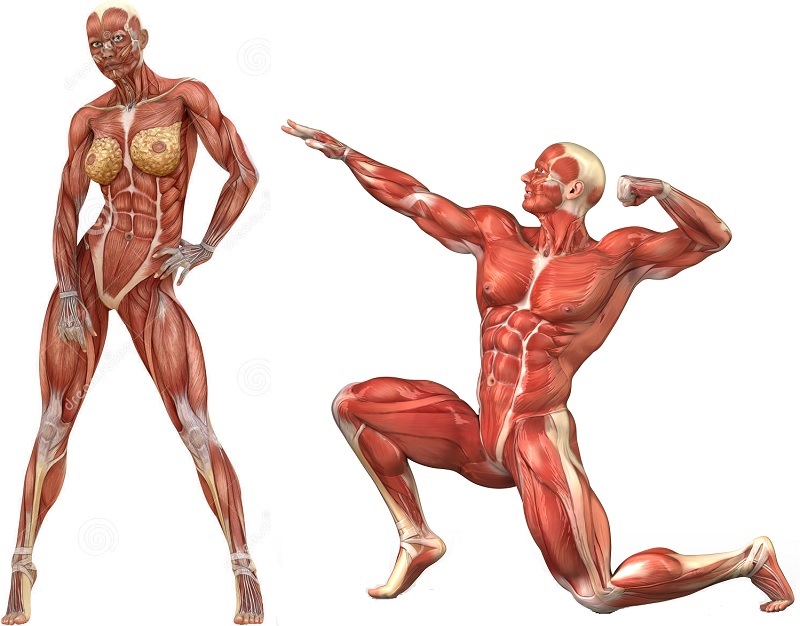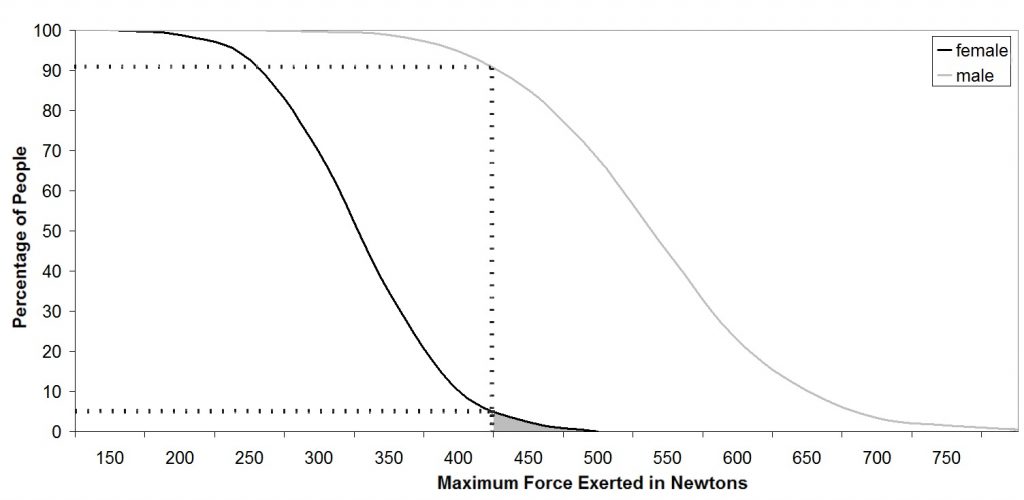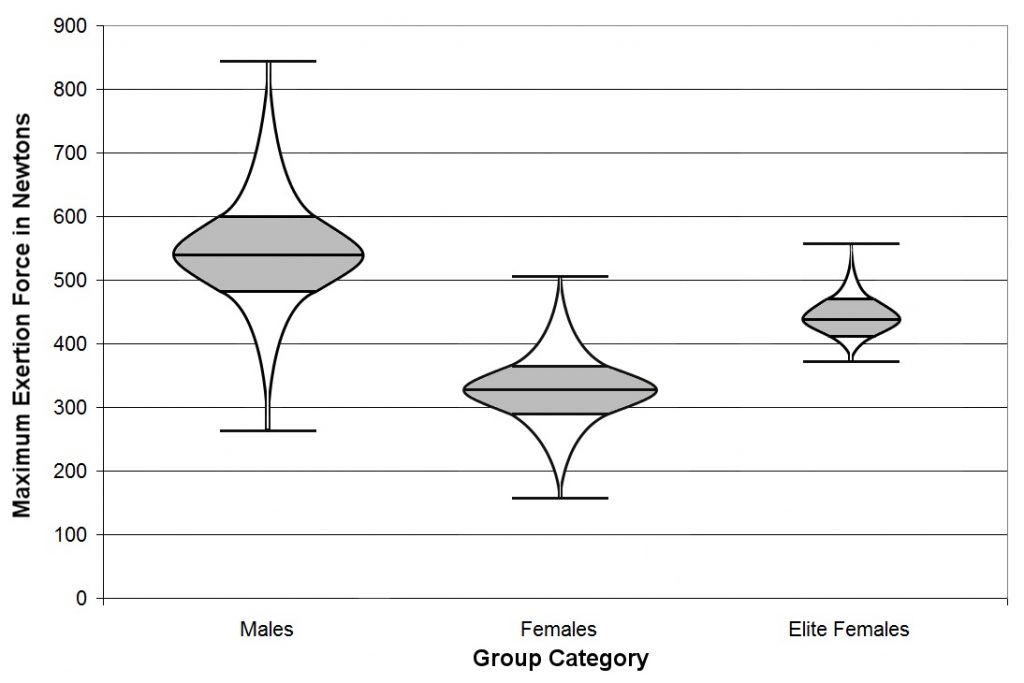
The following is an excerpt from the book “Smart and Sexy” by Roderick Kaine; a book mainly about the biological causes of sex differences in intelligence. (UPDATE: E-book now available for free) However, it also branches out into to topics which are closely related culturally or politically. For example, the same cultural milieu which enables the denial of relatively nuanced differences in intelligence more amazingly also encourages the denial of the much more strikingly obvious and extreme differences in physical attributes such as strength, endurance, and proneness to injury. The following excerpt covers this later topic. For additional excerpts and reviews, see this link. On a related note, you might also check out the 115 pound female fire fighter.
Though the focus of this work is not on differences in strength and endurance between genders, it is important to address this issue briefly because lack of acceptance of the greater physical ability of men has as much or more negative impact on the careers which require it as refusal to accept the innate cognitive differences does in the fields which require a minimum level of intelligence. If anything, the problem is even worse because while male and female intellectual differences are salient at the population level to those who look carefully, they can also be quite subtle at times.
Differences in physical strength, endurance, and athletic proficiency are an order of magnitude more striking. The average woman has only 52% of the upper body strength and only 66% of the lower body strength of the average man. Similar numbers are found when comparing muscular endurance. Another way to consider this difference is to look at the overlap in strength distributions between genders. When such a comparison is made, it turns out that only the strongest 2.5-5% of the female distribution overlaps with the male mean strength. Mirroring this, only the weakest 2.5-5% of male distribution overlaps with the mean female strength.i, ii, iii One study which measured hand grip strength found that 90% of females had less hand grip strength than 95% of male group. The strongest control group female was surpassed by 2/3rds of the male control group. In the same study, female athletes who specially trained for sports they played were also considered. Even these athletically elite females only managed to reach the 25th percentile of untrained males on average.iii Seemingly though, cognitive dissonance knows no bounds because there are feminists who would deny this reality in the face of unambiguous and overwhelming evidence; not to mention plain common sense.
From an evolutionary perspective, it was men who achieved status both to each other and to potential mates through physical competition and prowess; say, for example, through hunting.
Percentage of Males and Female with a Given Handgrip Strength or More

The graph above compares maximum male and female grip strengths. At any given strength level the percentage of males or females who were able, when exerting maximally, to reach at least that minimum level of force or greater is shown. For example, all volunteers could exert more than 150 Newtons worth of force so 100% of males and females could exert that level of force or more. As the minimum required force increases, progressively fewer people have the strength to exert that force. Dotted lines are used to compare the strongest 5% of females (shaded area) to the male curve. It can be seen from this comparison that just over 90% of males are stronger than 95% of females. In other words, the strength differences between males and females are so large that their distributions barely overlap even at the tales. Neither males nor females in this group engaged in special athletic training.
Data from D. Leyk, D., Gorges, W., Ridder, D., Wunderlich, M., Ruther, T., Sievert, A., Essfeld, D. (2007) Hand-grip strength of young men, women and highly trained female athletes. Eur J Appl Physiol (2007) 99:415–421 DOI 10.1007/s00421-006-0351-1
It is true that some men would profoundly lose in such competitions, and many probably died as a result. However, as was discussed previously, the species could accept increased mortality in males since the remainder could easily make up for those lost in terms of fertility.
Becoming an alpha female has never depended on raw physical strength to any great extent. In fact, the risks attendant with roles that require enhanced physical strength would likely serve to reduce female evolutionary fitness by increasing the chance of incurring fatal injuries; should she be physically capable of doing them.
Comparison of the Hand Grip Strength Distribution between Typical Males, Typical Females, and Elite Females

Above is a graph comparing the distribution of hand grip strength between typical males, typical females, and highly athletic females (i.e., elite females). Each distribution is divided into quartiles and each quartile is bounded by a horizontal black line. The grey area denotes 50% of the overall population (25th percentile to the 75th percentile). As can be seen from the graph, the strongest typical female is weaker than the male mean. Among the athletically trained female population, only the far tale of the distribution overlaps with the male mean. This indicates that even with training few women are able to attain a strength comparable with the untrained male population. This comparison does not include an athletically trained male population, but it can be expected that there would be little to no overlap with the female cohort if such a population was included. The shape of the curves were added as a qualitative representation of the relative population density at a given maximum strength where greater width indicates more of the population has that strength.
Data from Leyk, D., Gorges, W., Ridder, D., Wunderlich, M., Ruther, T., Sievert, A., Essfeld, D. (2007) Hand-grip strength of young men, women and highly trained female athletes. Eur J Appl Physiol (2007) 99:415–421
Since such risks present little advantage to females in terms of increased fertility, it is understandable why they would not evolve enhanced strength or why they might even move towards less strength to encourage increased outsourcing of provisioning and physical labor to male partners. With different pressures at work, males and females have understandably diverged with respect to their physical aptitudes. The main regulatory molecule which facilitates this is of course testosterone. However, muscular genes show a similar pattern as intelligence and spermatogenesis genes in that they also appear to be disproportionately X linked;Error: Reference source not found strongly implying that strength is an evolved sexually dimorphic, and possibly sexually antagonistic, trait.
The consequence of gender differences in strength is most obvious and unavoidable in the setup of our athletic competitions and games. There is no professional level or league which can be co-ed. Women simply are not physically capable of competing at the same level as men and must have separate leagues that virtually no one is interested in watching. This is not surprising because people are generally interested in watching the best compete, and that means men. Male athletic competitions are also more interesting because it is a method by which men can demonstrate their evolutionary fitness and relative level in social hierarchies. Athletic competitions do not serve this same purpose to any appreciable degree for women.
A notable example of direct competition that demonstrates the gulf between men and women was the tennis competition between Karston Braasch, who was ranked 203 in the professional men’s league, and the top ranked Williams sisters. Braasch won both games back to back with scores of 6 to 1 and 6 to 2. He was a decade and a half older than the sisters and past the physical peak age of his twenties. His preparation for the matches included smoking a pack of cigarettes and drinking several beers; yet the competition wasn’t even close.iv
The same pattern of differential suitability between genders in athletic competition is also true of physically demanding careers such as police officer or fire fighter. Ask yourself this, if you were caught in a fire and your life depended on a firefighter coming into the building, smashing down doors or walls with an axe, and then carrying you out, all while wearing extremely heavy protective gear, would you prefer a man or woman be the one sent to get you? If you have any interest in actually having your life saved, then the answer is obvious.
Similar arguments can be made for police officers who must have the physical ability to subdue criminals as part of their jobs. The idea of a female officer being able to physically subdue a fully grown male criminal is laughable. In one well-publicized example, prisoner Bryan Nichols, a large black male, over-powered an older female officer, took her gun, and went on a killing spree. False beliefs in gender equality in the case of firefighters and police doesn’t just result in wasted money or general inefficiency as in high IQ professions, it costs lives. Yet millions of taxpayer dollars are spent to accommodate the small number of women who are barely able to meet the physical standards of those professions; say by retrofitting fire stations to have female specific locker rooms and bathrooms which largely go unused.v And even if they are able to meet modern physical standards, that is only because the current standards have been relaxed compared to what they were in the past just so that more women could be placed in these roles. The actual physical demands have not decreased along with the standards.
Strength isn’t the only problem, either. Gender differences in bravery and risk-taking also matter. Jared Taylor, in his book Face to Face with Race, digresses from the general focus of the book to discuss the story of a female fire lieutenant who was hired and then promoted, in complete disregard for any sensible, merit-based physical standards. The hiring and promotion of this woman, like most female fire fighters, was done by the fire department to meet politically inspired quotas. When her crew arrived to a fire, instead of doing the standard procedure of dragging the heavy hose into the house, breaking down the door to the room on fire, and putting it out, she became afraid and reminded the crew that she was in command and ordered them not to enter. They were to try to put it out from the outside. Of course this didn’t work and it wasn’t until a male chief from a different crew showed up, relieved the cowardly woman of command, and ordered the firefighters to do the correct thing that the fire was put out. Later, the female fire fighter had a nervous break down as a result of her now widely known incompetence among the other fire fighters. She was reported to have started hitting herself repeatedly as part of this. She also became enraged at the fire department and sued them for “discrimination.”
Perhaps the most documented physically demanding career for which unsuitable women have been allowed to invade is the military. Quite literally, physical strength can mean the difference between life and death. In the chaos of battle, it can still sometimes be necessary to fight hand to hand in close combat situations. Even without actually resorting to the problem with females attempting to engage in hand to hand combat with men (let’s say that only guns are used), combat soldiers are still required to carry 70-100lbs of gear on long marches and into battle. This amount of gear tests the limits of male strength and endurance.vi How can it be expected for women, with only 50 to 66% of the strength of men, to carry this much? It can’t. The only way to put women into combat positions, which is the current object of feminist penis envy, is to lower standards and require less equipment. But the question is, what should female soldiers not carry? Should they have less armor? Less ammunition? Less food and water? How about less medical supplies? All of the things a soldier carries are potentially life saving, and without them that soldier and her fellow troops are at greater risk.
In addition, even cases which are, at first glance, seemingly beyond the need for physical strength can rapidly become physical tests of endurance. For example, it is quite possible for an airplane which comes under attack to lose engines and/or hydraulics. In such a situation, making an emergency landing requires a great deal of strength and endurance from the pilot. Most men would be able to handle this situation better than most women for purely strength related reasons.
There has been a large and foolhardy push for more women to be in the military and in combat specifically; which recently met with success. The only way to accomplish this is to lower standards for everyone, or simply expect less from women. Essentially, make it so women are paid the same for less work and ability. For example:
At the time of enlistment, a seventeen-year-old female is expected to do thirteen push-ups, compared to thirty-five for males, while for forty-one-year-olds, the numbers are six and twenty-four, respectively. A seventeen year-old girl is expected to run two miles in nineteen minutes, forty-two seconds or less, which is twelve seconds more than a forty-one year old man gets. A forty-one-year-old woman has to “run” two miles in twenty-four minutes and six seconds, almost five minutes more than a man receives.vii
More than 50% of female trainees in the marines are unable to do even three pull-ups. Instead they are required to do a “flexed arm hang” for a minimum 15 seconds; a much less stringent requirement.viii Over all age ranges, women can only do about one third the number of pushups compared to men; 30 vs. 10. Men average 2-4 fewer minutes per mile on long distance running tasks (7 vs. 10 minutes for a 1 mile run and 16 vs. 20 on a 2 mile run). Women can only do 40 sit ups on average compared to the male mean of 60.ix Female recruits also tend to be less physically fit on average (i.e., they are fatter). One of the most remarkable reductions in standards is the lowered minimum throwing radius expected of women throwing grenades. Women are only expected to be able to throw a grenade 25 meters compared to 35 meters expected of males and many can’t even throw it that far. What happens if a female combat troop muffs her throw and gets everyone around her killed? That incurring this level of increased danger to troops is accepted is incomprehensible, and yet that is how things are actually done today.x
Beyond simply having less physical strength, the female body also appears much less suited to strenuous physical exertion. Multiple studies have all found similar results: Women are consistently and significantly more likely to be injured. During basic training, it can be expected that 50% of female recruits will develop some sort of injury compared to 27% of men (i.e., they are 1.8 times more likely to be injured). Women are 2.5 times more likely to develop injuries that lead to significant time loss from training. More than 50% of women are prevented from ever completing their training because of some sort of injury. This pattern has been stable since the 1970s. xi, xii, xiii
Women are several orders of magnitude more likely to incur some specific injuries. For example, 1 in 367 female military personnel can be expected to suffer a pelvic stress fracture compared to only 1 in 40,000 men. This is unsurprising given that the female pelvis has evolved to accommodate childbirth, not heavy load bearing or other stresses. More generally, stress fractures occur about 10 times as often in women than men in the military. Depending on the study, ACL ruptures are between 2.4 and 9.7 more likely in women than in men. Overuse injuries, defined as an injury that results from extended, repetitive use of a specific body part, occur in 68% of women compared to 48% of men. The cumulative result of all of these injuries is that women must go to the doctor and seek medical care at 9.2 times the rate of men.xii
All these extra injuries constitute a huge additional immediate cost to military operations and can be expected to increase with additional female involvement in the military. However, the extra costs do not end in immediate medical costs. Injuries which cause sufficient damage result in physical disability discharges. Such discharges entitle the person who receives it to financial benefits for the rest of their lives. Consistent with their higher rate of injuries generally, women are 64% more likely to receive a physical disability discharge. And this was without them ever being intentionally exposed to combat situations at the time these studies were done. One year saw female disability discharge be as high as 140 per 10,000 female military personnel.xiv In the same year, male disability discharge was only 80 per 10,000 male military personnel, despite the fact that they are more commonly exposed to dangerous and/or physically demanding tasks. Disability costs take up an absolutely staggering amount of the military budget. In 2001, 21 billion dollars was paid out in compensation to disabled military service personnel when all services are considered. 25% of this disability compensation budget is made as direct cash payments and this was the level of payments before the recent Iraq and Afghanistan wars even took place.xi
Not to be misinterpreted, it is ethical to compensate soldiers who risk their lives and become disabled as a result of service. However, considering that women are so much more naturally prone to being disabled and that any individual woman can be expected to contribute less than any individual man on average, it makes little sense to have women in the military at all. In this case, women are definitely not equal in terms of what it costs to accommodate them.
i Miller, A. E., MacDougall, J. D., Tarnopolsky, M. A., Sale, D. G. (1993) Gender differences in strength and muscle fiber characteristics. Eur J Appl Physiol Occup Physiol. 1993;66(3):254-62.
ii Meyer, L. G., Pokorski, T. L., Ortel, B. E., Saxton, J. L., Collyer, P. D. Muscular Strength and Anthropometric Characteristics of Male and Female Naval Aviation Candidates. Naval Aerospace Medical Research Laboratory.
iii Leyk, D., Gorges, W., Ridder, D., Wunderlich, M., Ruther, T., Sievert, A., Essfeld, D. (2007) Hand-grip strength of young men, women and highly trained female athletes. Eur J Appl Physiol (2007) 99:415–421
DOI 10.1007/s00421-006-0351-1
iv (2001) How to… beat both Williams sisters in one afternoon. The Observer. The Guardian.
v Pelisek, C. (2008) Women Firefighters: The Gender Boondoggle. L.A. Weekly. http://www.laweekly.com/news/women-firefighters-the-gender-boondoggle-2151639
vi Tyson, A. S. (2009) Weight of combat gear is taking toll. Washington Post.
http://www.washingtonpost.com/wp-dyn/content/article/2009/01/31/AR2009013101717.html
vii Browne, K. (2007) Co-ed Combat: The New Evidence That Women Shouldn’t Fight the Nation’s Wars. Sentinel. ASIN: B000W94H5I
viii (2014) Marines delay female fitness plan after half fail pull-up test. Associated press.
ix Jones, B., Bovee, M., Knapik, J. (1992) Associations among body composition, physical fitness, and injury in men and women army trainees. National Academies Press. Body Composition and Physical Performance: Applications For the Military Services.
x Frum, D. (2013) The Truth About Women in Combat. Daily Beast. http://www.thedailybeast.com/articles/2013/03/01/the-truth-about-women-in-combat.html
xi Jordan, B. (2014) Data Predict Spike in Female Troop Injuries. Military.com. http://www.military.com/daily-news/2014/01/13/data-predicts-spike-in-female-troop-injuries.html
xii Springer, B.A., Ross, A. (2011) Musculoskeletal injuries in military women. Borden Institute.
xiii Bell, N.S., Mangione, T. W., Hemenway, D., Amoroso, P. J., Jones, B. H. (2000) High injury rates among female army trainees: a function of gender? Am J Prev Med. 2000 Apr;18(3 Suppl):141-6.
xiv Department of the Army (2011) Prevention and Control of Musculoskeletal Injuries associated with Physical Training. Department of the Army.





The world, or the West at least, has truly gone insane.
I’ve found that when women say, “Careful, that’s heavy” they have literally no clue how much stronger than them I am. It’s not really bragging, it’s just simple physics.
cry me a river, weak sissy fаggot
lmao he’ll slam you
Your mad with facts? lmao
Nah, you are living in a delusional macho fantasy. You are really not that much stronger, only 30 percent or less in the upper body. Also these differences are gradually disappearing as well, and in a not so far future men wont be any stronger. So say bye bye ta ta to your undeserved power and privilege since… forever. Your days of glory are over. And while on that topic, whoever wrote this article is spewing complete bullshit by citing that fraudulent book claiming there to be cognitive differences in men and women. The idea of male and female brain, (except for some hormone influenced areas affecting sexual attraction and gender identity) has been debunked by science, so please just stop, men are NOT more intelligent, they never have been, and never will be. They just like to think they are. You ONLY excel women in upper body strength, and maybe a bit in lower body, but that’s ABOUT IT! Get it through your thick confirmation bias fueled brain.
Cheers mah hairier and slightly bigger but dumber and primitive fellow human.
You’re so ignorant and uneducated. I’ve never seen anyone talk like that unless it was a fruit loop lmao. I can’t even take you seriously. Honestly just leave. You shouldn’t be allowed to reproduce.
You’re mad wih facts? And men being smarter than women definitely hasnt been debunked. Actually there’s a lot of teoriers and prroof, just like the “male variability”. Go to look at the top of the top, the top 100 smartest people in the world? 85 or 90 of them aare men.
You’re the one who’s living in a delusional “women can do everything a man can do” fantasy. And men are definitely stronger than women, by far more than 30%. They’re al also bigger, heavier, faster, more explosive, have mor endurance, they have better orientaion, better reflexes, better pain tolerance… All facts, search it c’mon.
Cry me a river.
Next time a female at the gym says that or something like that just scoff and say “maybe for you” and grab heavier weights.